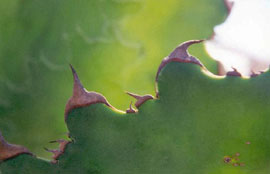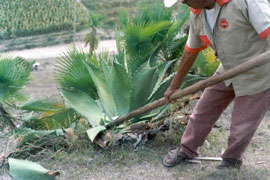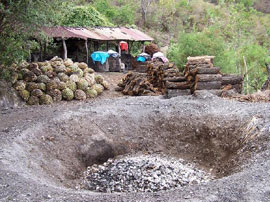Bottoms Up for Once Lowly Mezcal
Air Date: Week of October 22, 2004
Efforts are underway to lift mezcal up from its reputation as a poor man’s drink to one that can compete on the market with its better-known cousin, tequila. To reach that goal, ecologists are working with mezcal farmers and producers to make a product that is valued for its unique and diversified taste, and that is environmentally friendly, as well. Jana Schroeder reports.
Transcript
CURWOOD: Perhaps the best known liquor from Mexico is tequila. But tequila has a cousin called mezcal that’s also made from the agave plant, and it’s gaining in popularity. Mezcal used to be known as a poor man’s drink, with a worm at the bottom of the bottle, and mostly enjoyed by locals. For years it was outlawed, and that made for unpredictable quality and little availability for the lucrative export market. But now, high-quality, premium mezcal is edging its way into international trade with a marketing twist: small producers are branding their mezcal as an environmentally-friendly product, locally grown and produced. Jana Schroeder has our report from the Mexican state of Guerrero.
[ROOSTER CROWING; BACKGROUND NOISE]
 (Photo courtesy of GEA, AC)
(Photo courtesy of GEA, AC)
[MAN SPEAKING SPANISH]
SCHROEDER: Moises Calzada is one of the local mezcal masters. He learned how to make it as a boy, watching his father. Researchers date the tradition at least as far back as the 1600s. Today, Mr. Calzada is carefully selecting maguey plants —that grow wild here— for this year’s batch of mezcal.
[CHOPPING SOUNDS]
 A farmer chops off the outer leaves of the maguey plant. The heart of the plant is used to make mezcal. (Photo courtesy of GEA, AC)
A farmer chops off the outer leaves of the maguey plant. The heart of the plant is used to make mezcal. (Photo courtesy of GEA, AC)
[CALZEDA SPEAKING SPANISH]
SCHROEDER: Mr. Calzada leads me to a fire pit for roasting the maguey hearts. He explains that firewood is placed at the bottom of a deep hole in the ground.
[ROCKS BEING THROWN]
|
|
[BUBBLING SOUNDS] SCHROEDER: Not far away, another mezcal master is at work. Here, the maguey hearts have already been roasted and mashed, and the bubbling pulp is fermenting, in large tubs made of wood from local acayahuite trees. [FIREWOOD DUMPED AND STACKED] SCHROEDER: A load of firewood dumped on the ground was gathered from the surrounding hillsides and brought here by donkey. Three more loads will be needed as the source of heat for distilling this batch of mezcal. [WOMAN SPEAKING SPANISH] A woman tells us most people are careful to gather only dry, fallen wood — but environmentalists say deforestation is a growing concern. ILLSLEY: Where we are standing here, we can see several different situations. We have some slopes where there are many trees that people use for firewood….(FADES UNDER] SCHROEDER: Catarina Illsley is a biologist with the Mexico City-based Group for Environmental Studies. She points to some slopes where trees are still growing. And then to another slope where only maguey and palm are left. ILLSLEY: All other vegetation has disappeared, it has probably been all cut down, and the degree of deterioration is not as great as on the next one which is quite deteriorated. You can see, there’s almost nothing there, except the bare soil. SCHROEDER: She says once the trees and vegetation are gone, the soils here erode quickly. ILLSLEY: We think maguey could play a very important role in stopping this process of erosion because maguey has this great capacity to grow in very limited situations, where there practically is no soil left. SCHROEDER: Ms. Illsley’s environmental group is working in 30 communities here, together with a local farmers’ group called Sansékan Tinémi. They provide technical assistance for producing and marketing mezcal, while they’re promoting the sustainable management of natural resources. Together, they’re reforesting trees used for firewood, and collecting seeds from magueys to grow seedlings and plant them back in their natural habitat. And they’ve closed off reserve areas to prevent over-grazing by cattle, sheep and goats —and allow the magueys to grow back on their own. ILLSLEY: There are several reserves in different communities that have been closed off for, in some cases for seven years now, and there the forest has come back in a significant way. SCHROEDER: Ms. Illsley sees the model they’re developing for mezcal as an alternative to the environmental damage caused from making tequila. To make tequila, only one agave species is used, mostly in the Mexican state of Jalisco. The plants are cloned, and grown on large, single-crop plantations, in areas deforested or taken away from food crops. A lot of fertilizers and pesticides are used. In contrast, mezcal is made from different species, with naturally-occurring pollination —mostly by bats that feed on nectar from the flowers. Ms. Illsley says this guarantees genetic diversity, plus, unlike tequila, no chemicals are used in the field or in distillation. But, carving out a place in the market for mezcal isn’t easy. LARSON: The high demand and the high prices that tequila has achieved is putting negative economic incentives for the development of and use of local magueys. SCHROEDER: Jorge Larson works at Mexico’s National Commission for the Knowledge and Use of Biodiversity. LARSON: One of the strategies that we need to do is add value to these local and regional varieties, so they can compete on fairer conditions in the market. So, we can appeal to the consumer in terms of telling him you’re drinking a mezcal that is environmentally responsible. But it has to be high quality mezcal. SCHROEDER: New regulations, with on-site inspection and tighter controls, are aimed at guaranteeing quality and may bring higher prices. But some in Mexico are worried costs will also increase, and mezcal will become industrialized and homogenized. Jorge Larson says the identity of mezcal from specific regions should be protected, with local trademarks identifying the community it came from. LARSON: The basic character of mezcal is its wild sense, it’s non-domesticated character. It’s part of the personality of mezcal, to be diverse, so that in a sense has a lot of nice echoes between biological diversity and also the diversity of taste. The bet is that the market will value this, that we have wild mezcal drinkers that value this. SCHROEDER: In Mexico, there are growing numbers of mezcal connoisseurs. [PEOPLE TALKING AND LAUGHING. CLANK OF A BOTTLE HITTING GLASS, POURING OF SHOT] SCHROEDER: The people who came to this mezcal tasting in Mexico City are interested in supporting small producers who protect the environment and produce a chemical-free mezcal. The Group for Environmental Studies that organized the event, is following the scheme used for organic coffee and other fair trade products. The goal is to make the link between producers and consumers as direct as possible, while exporting high-quality products to the U.S. and Europe. Catarina Illsley points out that as recently as the 1970s, mezcal was not only unregulated but, in fact, illegal. ILLSLEY: And so, now that it is open, there are those industrials, especially the big tequila companies, that are interested in investing in mezcal – which means taking all the benefits. And we think it shouldn’t go that way. SCHROEDER: If her group has its way, small producers in Guerrero will receive a fair price for a premium mezcal. That’s come a long way since it was stored in a plastic jug and only shared with neighbors. For Living on Earth, I’m Jana Schroeder in Mexico. [MUSIC: Vangelis “Song of White” ANTARCTICA-THE ORIGINAL MOTION PICTURE SOUNDTRACK (Polydor – 1983) ] Living on Earth wants to hear from you!Living on Earth Newsletter [Click here]
Donate to Living on Earth! NewsletterLiving on Earth offers a weekly delivery of the show's rundown to your mailbox. Sign up for our newsletter today!
|

 A fire pit used for roasting maguey hearts. (Photo courtesy of GEA, AC)
A fire pit used for roasting maguey hearts. (Photo courtesy of GEA, AC) 



